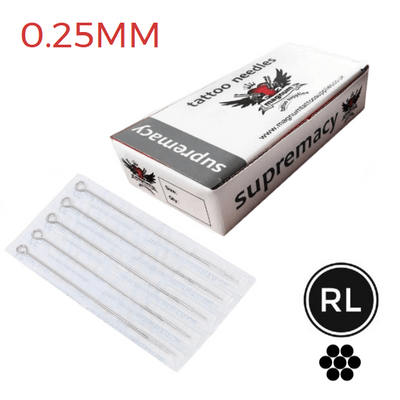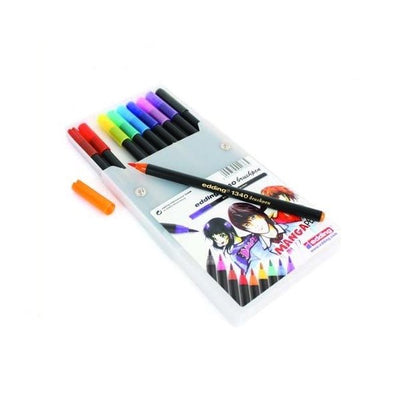Getting really good at doing line work tattoos is both hard and exciting. If you're learning to be a tattoo artist or you just love tattoos, understanding how to make those smooth, sharp lines can seem tough.
There are many things to watch out for, like making sure your lines are all the same thickness, not making the ink spread out under the skin, and keeping your hand steady. It takes a lot of tattoo practice and careful attention to get it right, but it's all about taking it step by step and learning from each try. So, let's discuss how to get those lines as sharp as your skills.
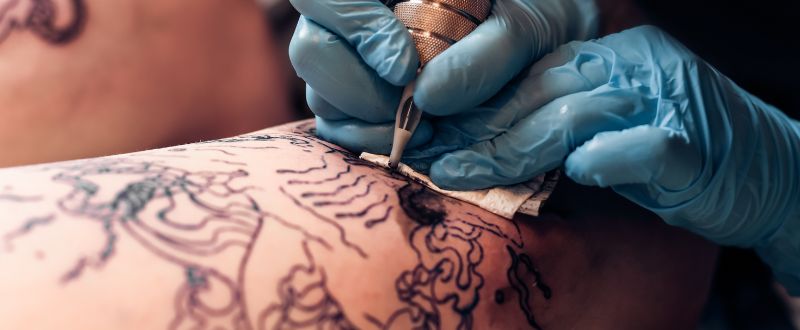
What is a line work tattoo?
A line work tattoo is a style of tattooing that emphasises clean, crisp lines to create designs, often without shading or colour fill. This technique focuses on outlines and minimalistic patterns, resulting in artwork ranging from simple geometric shapes and delicate florals to intricate illustrations and complex symbols. The simplicity of linework tattoos makes them visually striking and suitable for various aesthetic preferences.
Line types and uses
- Single needle lines: These are fine lines created with a single needle. They're used for intricate details and delicate designs, such as facial features, tiny symbols, or fine text. Single-needle lines are perfect for realistic tattoos, minimalist art, and subtle accents.
- Bold lines: Thick, bold lines are used to make a statement. They define shapes clearly and can be seen from a distance, making them suitable for larger tattoos or styles that require a strong outline, such as traditional or tribal tattoos. Bold lines are also used to convey strength and resilience.
- Shading lines: While not filled in, these lines vary in thickness and spacing to create a shading effect. This technique adds depth and dimension without traditional shading, giving the tattoo a more dynamic appearance.
- Dotted lines: Also known as dotwork, this involves creating images or shading with dots instead of continuous lines. It's used for textured effects, gradients, and subtle shading, often found in geometric tattoos or to add a three-dimensional quality to the design.
- Geometric lines: Straight, precise lines are used to create geometric shapes and patterns. These can symbolise balance, symmetry, and stability, and are often employed in sacred geometry tattoos, mandalas, or designs that represent personal beliefs or the cosmos.
- Continuous line: A single, unbroken line that twists and turns to create an entire design. This style emphasises fluidity and can represent a journey, connection, or the simplicity of a concept brought to life with a single stroke.
- Abstract lines: These lines are used to create abstract or surreal tattoos, often bending reality or combining elements in unexpected ways. They're employed to convey emotions, concepts, or a personal narrative that doesn't adhere to traditional visual forms.
Essential equipment
Needles
When choosing needles for line work tattoos, think about the detail you need. Fine lines require single needles or tight groupings, giving you sharp, precise results. For thicker lines, use larger groupings. The right tattoo needle ensures your tattoo looks clean and lasts longer.
Tattoo machines: Coil vs. rotary
You'll find two main types of tattoo machines: coil and rotary. Coil machines are great for detail, giving you control over intricate line work with their characteristic buzz. Rotary machines are quieter and smoother, good for both lines and shading and gentler on the skin. Your choice depends on what feels right for you and the tattoo you're doing.
Ink considerations
For line work, black ink is often used for its bold look, but you can choose from many colours. The type of ink affects how it looks on the skin and how long it lasts, so pick the best one for your design and skin type.
Techniques for mastering line work tattoo
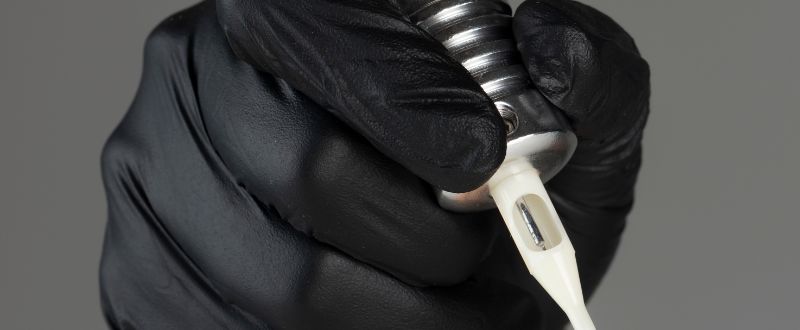
Mastering line work in tattooing requires practice, patience, and a deep understanding of various techniques. You can follow these strategies to help you improve your line work skills:
1. Understanding and adjusting your equipment
- Needle knowledge: Be familiar with various needle configurations and their specific uses. Round liners are great for fine lines, while magnum needles can produce thicker lines.
- Machine settings: Adjust your tattoo machine's speed and voltage to suit the type of line you're working on. Higher voltage is for thicker lines and lower is for finer lines.
2. Grip and machine control
Find a comfortable yet firm grip on your tattoo machine, which allows for greater control and steadier lines. It's also important to practice moving your hand and arm as a single unit, reducing reliance on wrist movements to achieve smoother, more consistent lines.
3. Practice makes perfect
Regularly practising drawing straight lines, curves, and transitions between different line thicknesses on practice materials like synthetic skin can significantly enhance your technique. This also includes mastering the correct angle and pressure to apply ink evenly and consistently.
4. Skin stretching techniques
Stretching the skin correctly is crucial. Use your non-dominant hand to stretch the skin tightly in the tattoo area to avoid jagged or inconsistent lines.
5. Line thickness and tapering
- Voltage adjustments for thickness: Adjust your machine's voltage to suit the thickness of the lines you draw. Higher voltage can create bolder lines.
- Tapering lines: Master tapering to smoothly connect lines or create sharp ends and points. This technique is essential for intricate designs.
6. Handling corners and curves
Approaching corners as if they are composed of two separate lines meeting at a point can greatly enhance the sharpness and precision of your angles. This method involves stopping at the corner and starting the next line, ensuring each segment is treated with attention to detail. It's particularly useful in geometric tattoos or designs with distinct angular components.
7. Long lines technique
For long, uninterrupted lines, moving your entire arm, hinging at the elbow, is often more effective than just using wrist movements. This technique provides greater control and helps maintain a consistent pressure and speed across longer distances. It's particularly useful for large tattoos or pieces that require extended straight or curved lines.
8. Continuous learning and feedback
Always be open to learning new techniques and receiving feedback from other artists. The tattooing industry is ever-evolving, and staying updated on new methods and equipment will enhance your skills.
Design considerations for line work tattoos
When designing line work tattoos, several considerations are crucial to ensure the final piece looks stunning on the skin and stands the test of time. Keep these key aspects in mind:
1. Simplicity and clarity
Linework tattoos thrive on simplicity and clarity. Even complex designs should have a clear structure and purpose for each line, ensuring the tattoo can be easily read and appreciated from a distance and up close. Overcomplicating a design with too many lines can lead to a muddled appearance, especially as the tattoo ages.
2. Flow and placement
Consider the tattoo's placement on the body and how it flows with the natural lines and contours of the skin. A well-placed linework tattoo can accentuate body curves or muscles, adding to the design's aesthetic appeal. The flow should feel natural and complementary to the body part it adorns.
3. Scalability
Think about how the tattoo's size will affect its visibility and detail over time. Fine lines may blur or spread as the skin ages, so it's important to ensure the design maintains its integrity even if some spreading occurs. This might mean opting for slightly thicker lines in small, detailed designs or ensuring enough space between lines in more intricate patterns.
4. Contrast and negative space
Using contrast effectively can make a line work tattoo stand out. This can involve playing with the thickness of lines or utilising negative space within the design to create visual interest. Negative space, where the skin is left bare, can be just as impactful as the inked areas in defining the overall look of the tattoo.
Common mistakes while doing line work tattoos
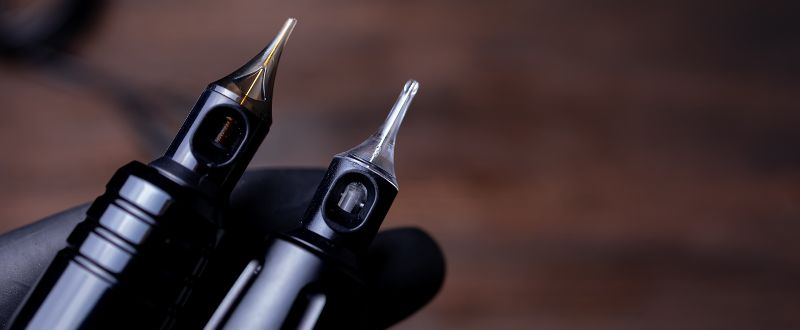
Creating line art tattoos involves precision and skill; even experienced tattoo artists can encounter challenges. Be aware of these common mistakes when doing line work tattoos or even other tattoo styles:
1. Inconsistent line thickness
One of the most noticeable mistakes is inconsistency in line thickness. This can happen due to uneven pressure, incorrect needle depth, or not maintaining a steady hand speed. Inconsistent lines can make a tattoo appear shaky or amateurish.
2. Blowouts
Blowouts occur when ink spreads beneath the skin outside the intended line path, creating a blurred effect around the line. This can result from inserting the needle too deeply into the skin or using too much force. Blowouts can significantly compromise the clarity and precision of linework tattoos.
3. Uneven line quality
Uneven line quality, including patchy or skipped areas within a line, can happen if the ink isn't flowing properly or if the artist moves the needle too fast or too slow relative to the machine's speed. This mistake requires going over the line again, leading to thicker lines than intended or additional trauma to the skin.
4. Poor planning and placement
Failing to consider the body's contours and movement can lead to designs that look distorted or misplaced once healed. Poor planning regarding the size and placement of a tattoo can also affect its visibility and how it ages over time.
5. Overworking the skin
Overworking occurs when an artist goes over the same area too many times in an attempt to correct mistakes or make lines thicker, leading to increased trauma to the skin. This can cause excessive swelling, longer healing times, and even scarring, affecting the tattoo's final appearance.
6. Holding the tattoo machine incorrectly
An improper grip on the tattoo machine can lead to reduced control and inaccurate line work. A comfortable, stable grip for precise movement is vital for producing clean lines.
7. Moving your hands too fast or slow
The speed at which you move your hand is crucial. Moving too fast can result in faint lines, while moving too slowly might deposit too much ink, leading to bleeding. Finding a balance that allows for smooth, consistent ink application is essential.
Learning line work tattoos
And there you have it! Mastering line work tattoos is a journey filled with learning, growth, and, let's not forget, a bit of fun. Whether you're an artist holding the machine or an enthusiast appreciating the art, remember that every line tells a story. So, keep practising, stay patient, and most importantly, enjoy the ride. Who knows? The next line you draw could be your masterpiece.



























































 Studio supplies
Studio supplies












 Power & batteries
Power & batteries








 Aftercare
Aftercare





















 Apprentice
Apprentice


 Piercing & jewellery
Piercing & jewellery







 PMU supplies
PMU supplies




 New arrivals
New arrivals
 Gift vouchers
Gift vouchers
 Shop all
Shop all





